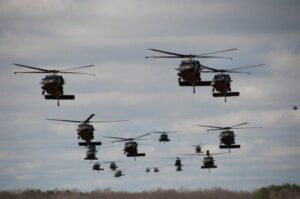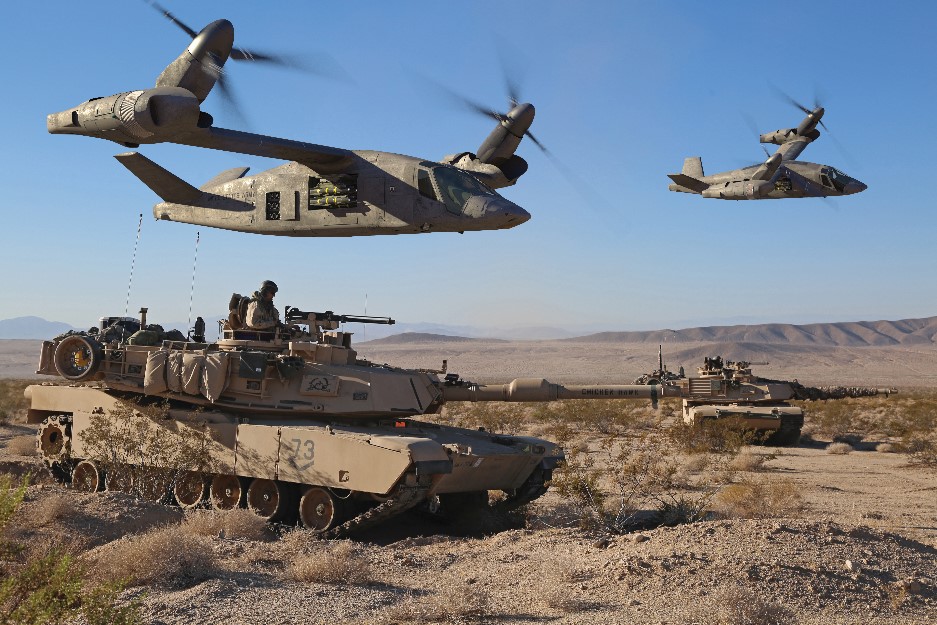Big SPAR Army Review May Topple ITEP
Posted on

Critics say the Army could end up wasting billions by developing a better engine for its Sikorsky UH-60 Black Hawk and Boeing AH-64 Apache helicopters even as the joint Future Vertical Lift (FVL) initiative gets underway to replace those aircraft. The critics are wrong, program officials assure us. But the critics still disagree. A new Army budget exercise may settle the dispute.
We raised the timing question in an Aug. 23 article about the Army’s Improved Turbine Engine Program (ITEP), which is scheduled to start producing helicopter engines in fiscal 2024 and go into full rate production in 2026. That’s a mere four years before the Army-led FVL plans to launch a program to produce a far faster, more agile medium-sized Vertical Takeoff and Landing (VTOL) aircraft for all the services that would replace the Army’s Black Hawks and Apaches.
“It would probably take us 30 years to replace all the Black Hawks in the fleet,” said Richard Kretzschmar, project manager for ITEP and the Army-led FVL both. In the meantime, he said, those Black Hawks and Apaches are going to need the ITEP engines, designed to fit into the airframe spaces but produce 3,000 shaft horsepower instead of the current engine’s maximum 2,000 shp.
Billed as Army aviation’s “top modernization priority program,” the $10 billion ITEP (pronounced “EYE-tepp”), recently awarded preliminary design review contracts to GE Aviation, which produces the engines the Black Hawk and Apache currently use, and to the Advanced Turbine Engine Co. (ATEC), a 50-50 joint venture formed by Pratt & Whitney and Honeywell.
The goal of FVL, meanwhile, is to develop three sizes of advanced VTOL aircraft – light, medium, and heavy – to replace most helicopters used by the military. The plan is to begin with what insiders call the Capability Set 3 aircraft, using the term the FVL office adopted for lists of requirements it has developed for the various aircraft envisioned.
“We are going to have Black Hawks in conjunction with Cap Set 3 aircraft for a long, long time,” Kretzschmar said. “ITEP is intended to buy back the capability we need out of the Black Hawks and Apaches and keep them relevant far out into the future.”
Kretzschmar’s arguments were echoed by Dan Bailey, program director of FVL’s Joint Multi-Role Technology Demonstrator (JMR TD) program, under which Bell Helicopter and a Sikorsky-Boeing team are building new VTOL aircraft. Bell’s V-280 Valor tiltrotor and the Sikorsky-Boeing SB>1 Defiant, a compound helicopter with a coaxial rotor and a pusher propeller, are to fly next year – at projected speeds more than twice as fast as Black Hawks and Apaches.
“There’s no way of getting around that you’re going to have to continue to use Apaches and Black Hawks for years to come regardless of when we get FVL production lines started,” Bailey argued.

Bell V-280 Army with tanks
But a retired senior Army aviation officer said the timing anticipated by those officials is based on an Army acquisition strategy that may change dramatically next year. While the JMR TD aircraft are merely demonstrators, he added, the companies building them are confident they could move through the next stages of development and into production much quicker than under current FVL plans.
“Our message has constantly been that you don’t need to wait that long,” confirmed Bell’s V-280 program manager, Vince Tobin. “We’re ready for this platform, even with some modest requirements changes, to be ready for the engineering and manufacturing development phase to start as early as 2020.”
The Army, meanwhile, is preparing to conduct a Strategic Portfolio Analysis and Review (SPAR) that could shake up acquisition schedules across the service. Under the SPAR about 780 existing Army programs are to be subjected to rigorous review from November through January against a scenario modeled on a “high-end, decisive-action war fight,” as Lt. Gen. John M. “Mike” Murray, deputy chief of staff for force development, put it to our colleague Courtney McBride of Inside the Army in an Aug. 29 interview. Programs are to be ranked in categories, with the most important accelerated and the least vital cancelled to free up funds.
At an Association of the United States Army breakfast last week, Murray cited the joint FVL initiative as a low priority for his service. “We will not be able to afford Future Vertical Lift until we buy out the Apache and the UH-60 fleet, just because there’s no money to do it concurrently,” Murray said.
But the retired senior Army aviation officer said the SPAR exercise could reverse that thinking by showing Murray and other senior leaders how much more potent the Army could be with faster VTOL aircraft that also offer far greater range and other capabilities than conventional helicopters.
“If the SPAR process holds up to its advertised benefit, the Army’s going to see that an aircraft like the future vertical lift is a critical capability for future full-spectrum conflict,” this retired officer said. “Something that flies twice as far, twice as fast, far more than capable — it’s not an incremental improvement to what we have today but rather a step change.”
If Army leaders buy that argument, he added, “Then they’re going to have to decide to curtail their investment in current modernization programs and redirect that money into Future Vertical Lift. If that happens, then ITEP will not make any sense at all” and “one of the places they would find money for FVL is not only the aircraft modernization program but also the ITEP.”
Let the budget wars begin.
Subscribe to our newsletter
Promotions, new products and sales. Directly to your inbox.
